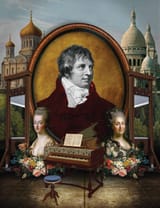Search Results
6/27/2025, 8:54:35 PM
Anon, we're all worried about you. Why aren't you listening to Dussek? What's wrong?
https://www.youtube.com/watch?v=oo1XHgO8asU
https://www.youtube.com/watch?v=XgbhJrZTroc
https://www.youtube.com/watch?v=-QXDNEQW4t8
https://www.youtube.com/watch?v=EDCC2FjhFBs
https://www.youtube.com/watch?v=PLZOJgz4jEM
https://www.youtube.com/watch?v=BBIrH8XzxRI
https://www.youtube.com/watch?v=03v_yujz2BY
https://www.youtube.com/watch?v=oo1XHgO8asU
https://www.youtube.com/watch?v=XgbhJrZTroc
https://www.youtube.com/watch?v=-QXDNEQW4t8
https://www.youtube.com/watch?v=EDCC2FjhFBs
https://www.youtube.com/watch?v=PLZOJgz4jEM
https://www.youtube.com/watch?v=BBIrH8XzxRI
https://www.youtube.com/watch?v=03v_yujz2BY
6/21/2025, 4:00:38 AM
>Along with Clementi, Dussek may have been a source of stylistic inspiration and influence for Beethoven, whose expansion upon the idiomatic innovations of the London school led to their rapid penumbration with the appearance of Beethoven's own keyboard works. Stylistic, melodic, dynamic and structural similarities exist between Beethoven's Sonata Opus 10, No.3 and Dussek's Sonatas Opus 31, No.2 and Opus 35, No.2. Similarly, the opening of Beethoven's Sonata Opus 10, No.1 quotes directly Dussek's Sonata Opus 39, No.3. It is also possible that Dussek's influence can be seen in Beethoven's famous Sonata Opus 81a, les Adieux: "both the program and the realization owed a great deal to Dussek's Opus 44."
>Dussek introduced one noteworthy stylistic innovation to the piano concerto form. In variance with the prevailing classical concerto style, exemplified by Mozart's piano concertos, Dussek eliminated the soloist cadenza in the opening movement in all of his concertos written after 1792. His Concerto in C major, Op. 29, published in 1795, starts with an introductory Larghetto in 3/8 time, a solemn thematic declamation that is unique to the classical concerto. His last surviving work in the genre, Op. 70 in E-flat major, was one of the first to lengthen substantially the opening movement: at 570 measures long, roughly a third longer than previous contributions, it foreshadows the practice of a dominant opening movement in concertos, as in the concertos of Chopin and the Opp. 85 and 89 by Hummel as well as Beethoven's fifth.
>Dussek is important in the history of music because of his friendship with John Broadwood, developer of the "English Action" piano. Because his music demanded strength and range not available in then current pianos, he pushed Broadwood into several extensions of the range and sonority of the instrument. It was a Broadwood instrument with Dussek's improvements that was sent to Beethoven.
https://www.youtube.com/watch?v=oo1XHgO8asU
>Dussek introduced one noteworthy stylistic innovation to the piano concerto form. In variance with the prevailing classical concerto style, exemplified by Mozart's piano concertos, Dussek eliminated the soloist cadenza in the opening movement in all of his concertos written after 1792. His Concerto in C major, Op. 29, published in 1795, starts with an introductory Larghetto in 3/8 time, a solemn thematic declamation that is unique to the classical concerto. His last surviving work in the genre, Op. 70 in E-flat major, was one of the first to lengthen substantially the opening movement: at 570 measures long, roughly a third longer than previous contributions, it foreshadows the practice of a dominant opening movement in concertos, as in the concertos of Chopin and the Opp. 85 and 89 by Hummel as well as Beethoven's fifth.
>Dussek is important in the history of music because of his friendship with John Broadwood, developer of the "English Action" piano. Because his music demanded strength and range not available in then current pianos, he pushed Broadwood into several extensions of the range and sonority of the instrument. It was a Broadwood instrument with Dussek's improvements that was sent to Beethoven.
https://www.youtube.com/watch?v=oo1XHgO8asU
Page 1
